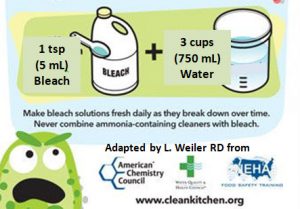You can protect yourself from COVID-19 by preventing the spread of germs. Although there are not many studies on COVID-19 specifically, scientists suggest that what we know works against other coronaviruses could work against this new strain too. Well known food safety cleaning and sanitizing practices can kill many different kids of harmful germs that cause disease. Consider these expert tips for cleaning and sanitizing surfaces you use for food handling and preparation to reduce your risk of COVID-19 exposure.
3 Food safety rules to sanitize kitchen surfaces
- CLEAN: Remove dirt by washing down surfaces using warm soapy water & rinse with clean water.
- SANITIZE: This step reduces the harmful germs to safe levels on surfaces so illness is less likely to occur. Before preparing meals food safety pro’s make sure that counters, cutting boards and work surfaces are sanitized first. Chemicals approved as sanitizes for food-contact surfaces in food-service are chlorine, iodine and quaternary ammonium. Diluted chlorine bleach is a very effective sanitizer that is easy to make at home too. You can make your own sanitizing spray using 1 tsp (5 mL) bleach for every 3 cups (750 mL) of water. (Ministry of Health & LTC Ontario) This sanitization method works for both plastic and wooden cutting board, taps, sinks and other surfaces. (Note: Bleach is NOT recommended for marble or stone countertops!)
- AIR DRY: Let surfaces air dry or dry with a clean disposable paper towel.
More tips on cleaning and sanitizing in the kitchen are available at this link: https://extension.colostate.edu/docs/pubs/foodnut/kitchen-sanitize.pdf


Contact us for comments or questions.